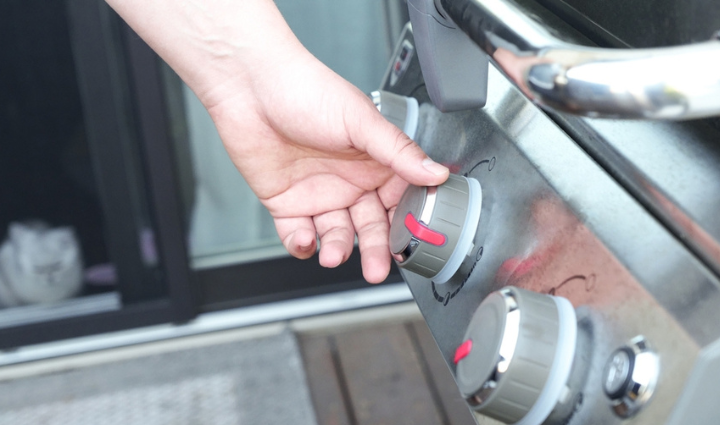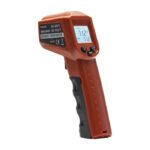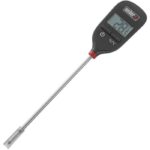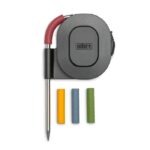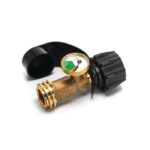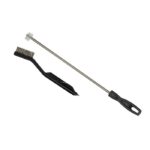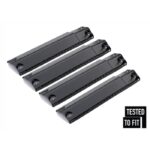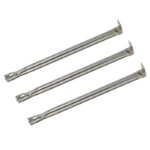Grilling on a gas grill is supposed to be simple, but if you’ve ever scorched a steak or struggled with uneven heat, you know that managing gas grill temperature isn’t always as effortless as it seems.
Mastering gas grill temperature is the secret to better grilling. It’s what helps you sear a perfect steak, keep chicken juicy, and avoid flare-ups that char your food before it’s done. Whether you’re an occasional weekend griller or a seasoned pro, understanding how to control and maintain your barbecue’s temperature will take your cookouts to the next level.
In this guide, we’ll break down everything you need to know to keep gas grill temperatures steady.
Let’s get started.
Setting Up Heat Zones to Control Gas Grill Temperature
One of the best ways to manage your gas grill temperature is by creating distinct heat zones on your grill. Using heat zones allows you to cook multiple foods at once, manage flare-ups, and make adjustments quickly if temperatures start to swing. It’s also one of the most effective ways to manage your barbecue’s temperature, no matter what you’re cooking.
There are two heat zones you’ll need to create: direct and indirect heat.
What’s the difference between direct and indirect heat?
- Direct heat cooking means placing food directly over the lit burners. This is the high-heat zone – great for quick-searing steaks, burgers, or vegetables. Think of it like broiling in your oven.
- Indirect heat cooking means the burners under the food are turned off, and the heat comes from the sides and surrounding air. It’s perfect for slow-cooking thicker cuts or delicate items without burning. This is more like roasting or baking.
- Combo method: This technique starts with cooking over direct heat to get a nice sear, then moving the food to indirect heat to finish cooking more gently. It’s ideal for bone-in chicken, pork chops, or thick-cut steaks.
How to set up your burners for heat zones
How you create your heat zones depends on how many burners your grill has:
- 2-burners: Turn on one burner and leave the other off. Use the lit side for searing and the unlit side for indirect cooking or keeping food warm.
- 3-burners: Set one burner to high, one to medium or low, and leave the third off. This gives you three distinct temperatures to work with: a searing zone, a moderate cooking zone, and a safe zone for indirect heat. If your grill temperature gets too high, you can turn two burners off and play with the heat output on the remaining burner.
- 4-burners: Turn off the middle two burners and leave the outer ones on. Place food in the center of the grill for indirect cooking. Since the heat is further away from the food, you may need to increase the burner settings slightly to maintain your target temperature.
Preheating Your Grill to Stabilize Gas Grill Temperature
Preheating your grill is one of the most important steps in controlling gas grill temperature. Skipping it can lead to uneven cooking, your food sticking to the grate, and longer grill times.
Why preheating matters
When you preheat your gas grill, the burners, grates, and internal air temperature all heat up together. This creates a consistent cooking environment, which is especially important when searing meat or setting up indirect heat zones. It also helps burn off any leftover residue from previous cooks, keeping your food clean and flavorful.
How long should you preheat?
Most gas grills take 10 to 15 minutes to preheat properly. You’ll want to:
- Turn all burners to high and close the lid.
- Wait until your built-in thermometer reaches around 450-500°F (260°C).
- Once preheated, adjust the burners to your desired cooking temperature or set up your direct or indirect heat zones.
Using a Thermometer to Monitor Gas Grill Temperature Accurately
If you really want to take control of your gas grill temperature, a built-in lid thermometer won’t cut it on its own. While convenient, these gauges measure the temperature of the air near the top of the grill, not the actual temperature at the grate, where your food is cooking.
Lid thermometers often run 50–100°F higher than the grate-level temperature, especially when cooking with the lid closed or using indirect heat. That can lead to undercooked or overcooked food if you’re relying on it alone.
For more precise control, use a dedicated grill surface thermometer or a digital probe thermometer with a clip that positions the sensor right at the grate level. These tools give you a real-time, accurate readout of what’s happening where it matters most. Some modern digital thermometers even let you monitor multiple zones at once, which is especially helpful if you’re using a 2- or 3-zone setup.
GRILL SPOT TIP: Keep an eye on the temperature of each heat zone. If you’re cooking with indirect heat, place a thermometer probe in both the direct and indirect zones so you can see how your heat is distributed. This is a great way to fine-tune your burner settings and keep your gas grill temperature steady throughout the cook.
Shop for grill thermometers:
How To Prevent Flare-Ups That Spike Gas Grill Temperature
Flare-ups are one of the fastest ways to lose control of your gas grill temperature. Even a small flare-up can spike the temperature by 100°F or more, especially in a closed-lid environment. That makes flare-up management essential if you’re aiming for even cooking.
What causes flare-ups?
Flare-ups happen when fat or oil drips onto the burners or flame tamers, causing sudden bursts of fire that can scorch your food and create wild heat swings. They are especially common when:
- You are cooking fatty cuts of meat (like burgers, sausages, or chicken thighs)
- You’re using marinades or sauces with oil or sugar
- You have grease buildup on your burners or flavor bars
How to reduce the risk of flare-ups
You can’t eliminate flare-ups entirely, but you can minimize them with a few smart grilling habits:
- Trim excess fat from meats before grilling.
- Use a drip pan beneath the food when cooking with indirect heat.
- Keep your grill clean—grease buildup on burners and flavor bars is a common flare-up culprit.
- Grill with the lid closed to reduce oxygen and snuff out small flare-ups quickly.
What to do when a flare-up happens
- Move the food to a cooler zone or indirect heat.
- Lower the heat output of the burner beneath the flare-up, or shut it off temporarily.
- Keep the lid closed if it’s a small flare-up—it helps reduce oxygen and settles the flames faster.
- Avoid spraying water, which can cause steam burns and grease splatter.
Tips For Maintaining a Consistent Gas Grill Temperature While Cooking
- Keep the Lid Closed: Resist the urge to peek. Every time you open the lid, you let heat escape and you throw off your grill’s internal balance. This is especially important when cooking with indirect heat or trying to maintain a low-and-slow temperature range.
- Don’t Overcrowd the Grill: Cramming too much food onto the cooking surface restricts airflow and makes it harder for heat to circulate evenly. Leave space between items to allow consistent heat distribution and reduce the risk of flare-ups.
- Adjust Burners Gradually: If you need to tweak the heat, make small adjustments to your burners, then wait a few minutes to let the grill stabilize. Cranking the knobs too high or low can lead to overcorrection and temperature spikes or drops.
- Watch the Weather: Wind, cold air, and even the sun can all affect gas grill temperature, especially if your grill is on an open patio or balcony. On windy days, position the grill so the breeze hits the back, not the sides or front of the grill. In cooler weather, preheat a bit longer and monitor more frequently.
- Monitor Propane Levels: Low propane levels can cause a sudden drop in heat output, especially during longer cooks. If your flame seems weak or inconsistent, check your fuel level and have a spare tank ready just in case.
How To Troubleshoot Unstable Gas Grill Temperatures
Even if you follow all the right steps, you might still notice temperature swings from time to time. When your barbecue temperature doesn’t stay steady, it usually comes down to one of a few common issues, most of which are easy to fix.
Problem: Low propane levels
A nearly empty tank can cause the flame to flicker or weaken, especially during high-heat or slow cooks.
Solution: Check your propane tank. Here’s how to check your propane tank using just soap and water. You can also consider adding a propane tank gauge to keep an eye on how much gas is left in your tank.
Shop for a propane gauge:
Problem: Dirty or clogged burners
Grease, food debris, or insects can block gas flow to your burners, leading to uneven flames and cold spots on the grill.
Solution: Clean your burners and venturi tubes. Use a venturi brush or pipe cleaner to remove buildup. Make sure burner holes are clear and the flame is even across the length of the burner. Follow our step-by-step directions for cleaning your gas grill burners.
Shop for burner brushes:
Problem: Faulty regulator
If your grill suddenly won’t heat past a certain point, your gas regulator may have tripped into bypass mode. This is common if the tank valve was opened too quickly.
Solution: Reset the gas regulator. To reset, turn off the tank and all burner knobs, then disconnect the regulator from the tank. Wait 30 seconds, then reconnect and slowly open the tank valve. This can clear a regulator lockout and restore proper gas flow. Follow our detailed step-by-step directions for resetting your regulator.
Problem: Leaky connections
Gas leaks or loose hose fittings can disrupt the flow of fuel, leading to inconsistent heating or low flame output.
Solution: Test for leaks. Use a 50/50 mix of water and dish soap to check connections. If you see bubbles forming, tighten the fittings or replace faulty parts. Here’s our detailed guide on how to check for gas leaks.
Mastering Gas Grill Temperature Starts Here
Controlling your gas grill temperature is one of the most important skills any backyard griller can learn. Whether you’re searing over high heat, slow-cooking with indirect zones, or troubleshooting temperature dips, knowing how your grill responds puts you in control of every cookout.
With the right setup, tools, and a little practice, you’ll be able to grill more confidently and more consistently. From preheating and burner control to flare-up management and thermometer placement, every step you take to stabilize your grill’s temperature pays off in better results on the plate.
Need better temperature control? If your burners are heating unevenly or your thermometer is unreliable, it might be time for an upgrade or replacement. Browse our collection of high-quality replacement grill parts, including burners, heat plates, and temperature gauges, and bring your gas grill back to peak performance.
Shop for grill parts:
Sources
- “How to Use Indirect Heat on Your Gas Grill for Low-and-Slow Flavor.” Karla Walsh. October 11, 2024. bhg.com.
- “Taming the Flame: A Grilling Refresher On Controlling The Heat.” Elizabeth Karmel. May 10, 2021. forbes.com.

